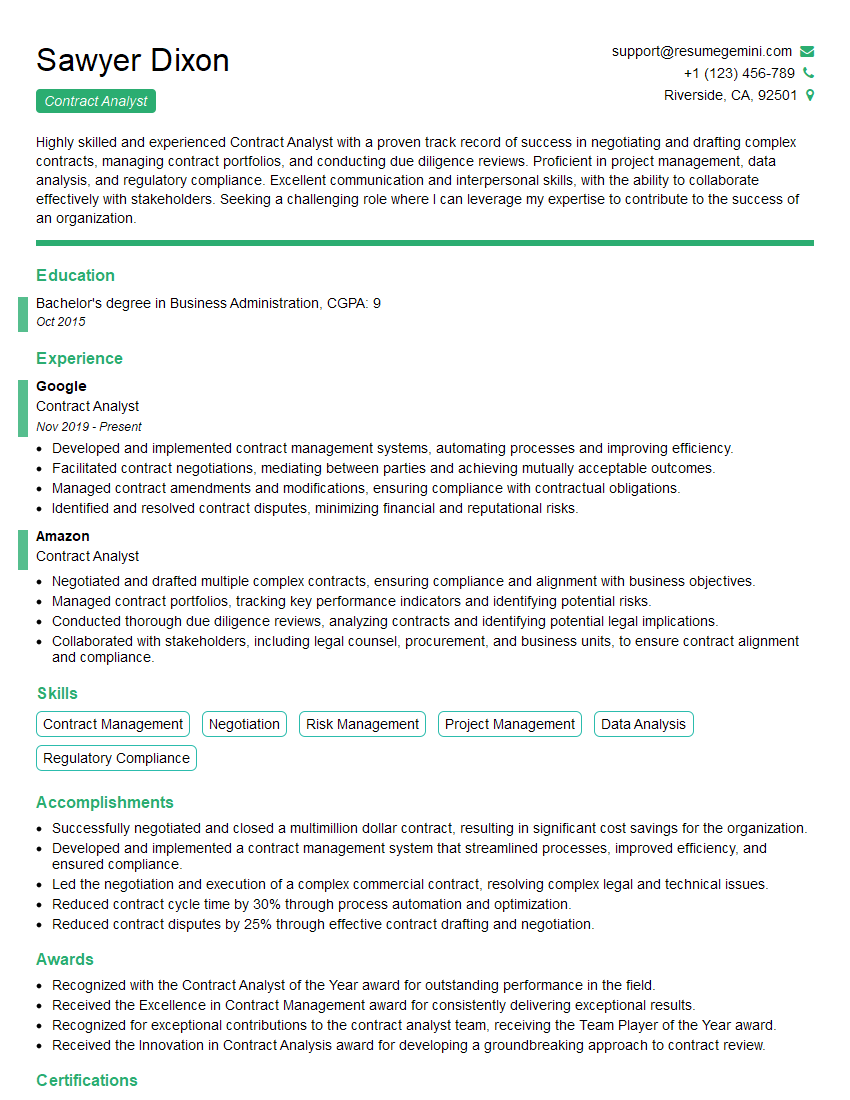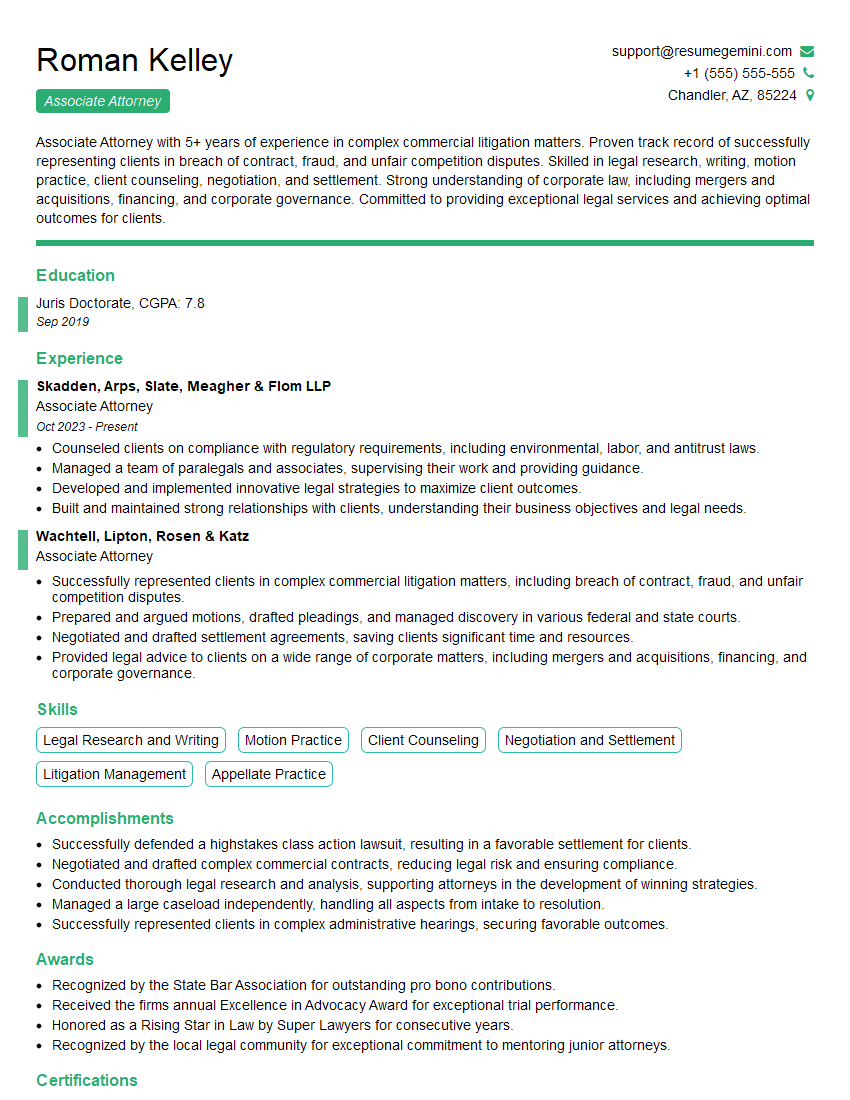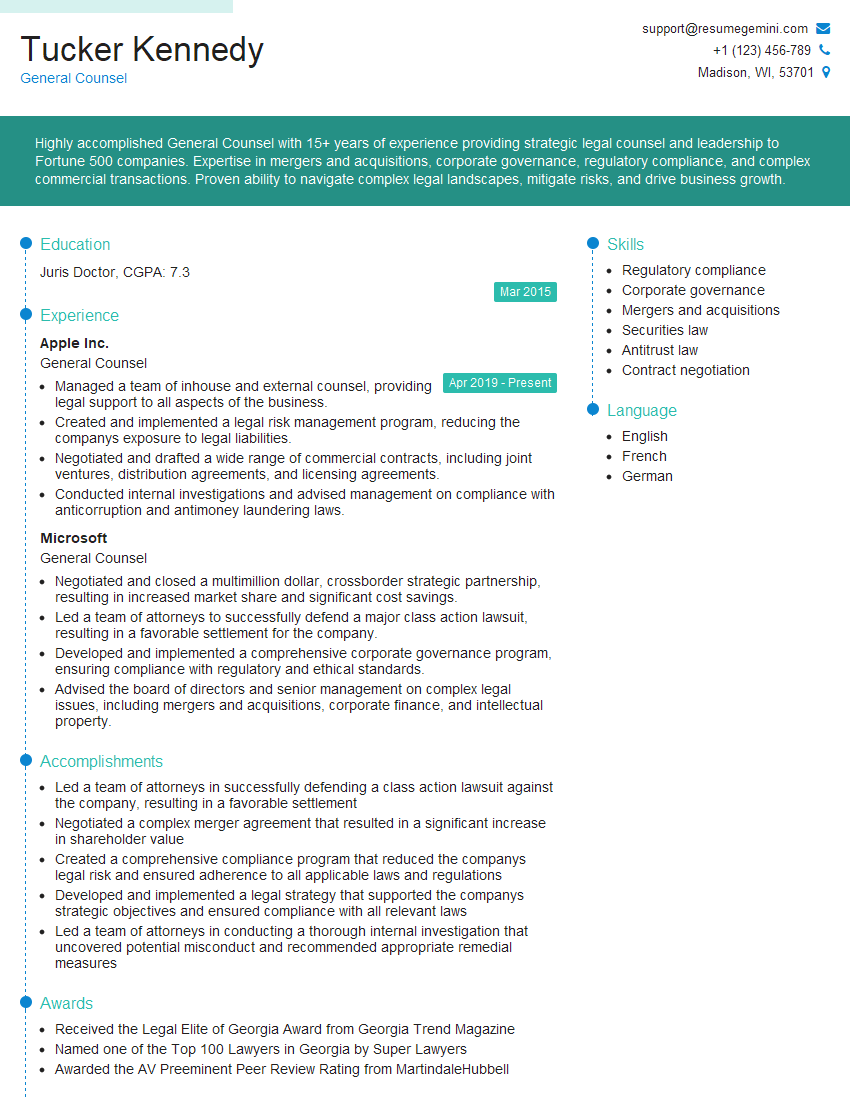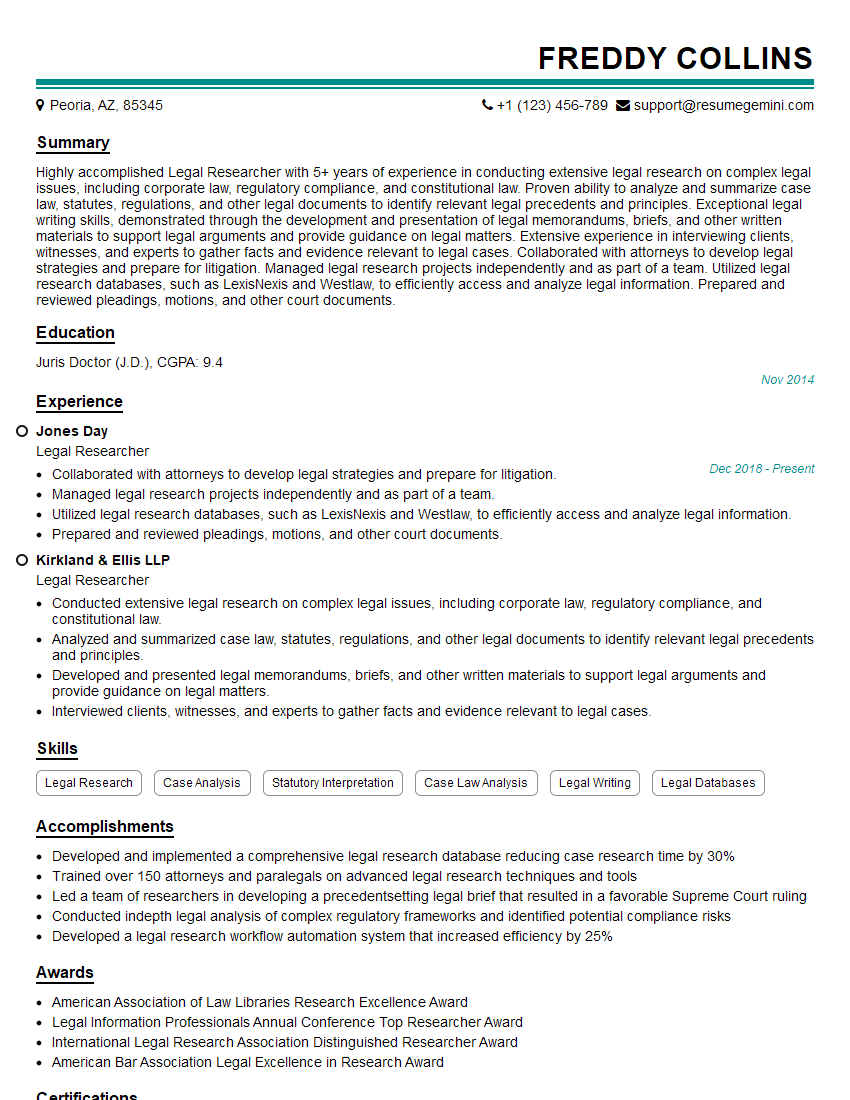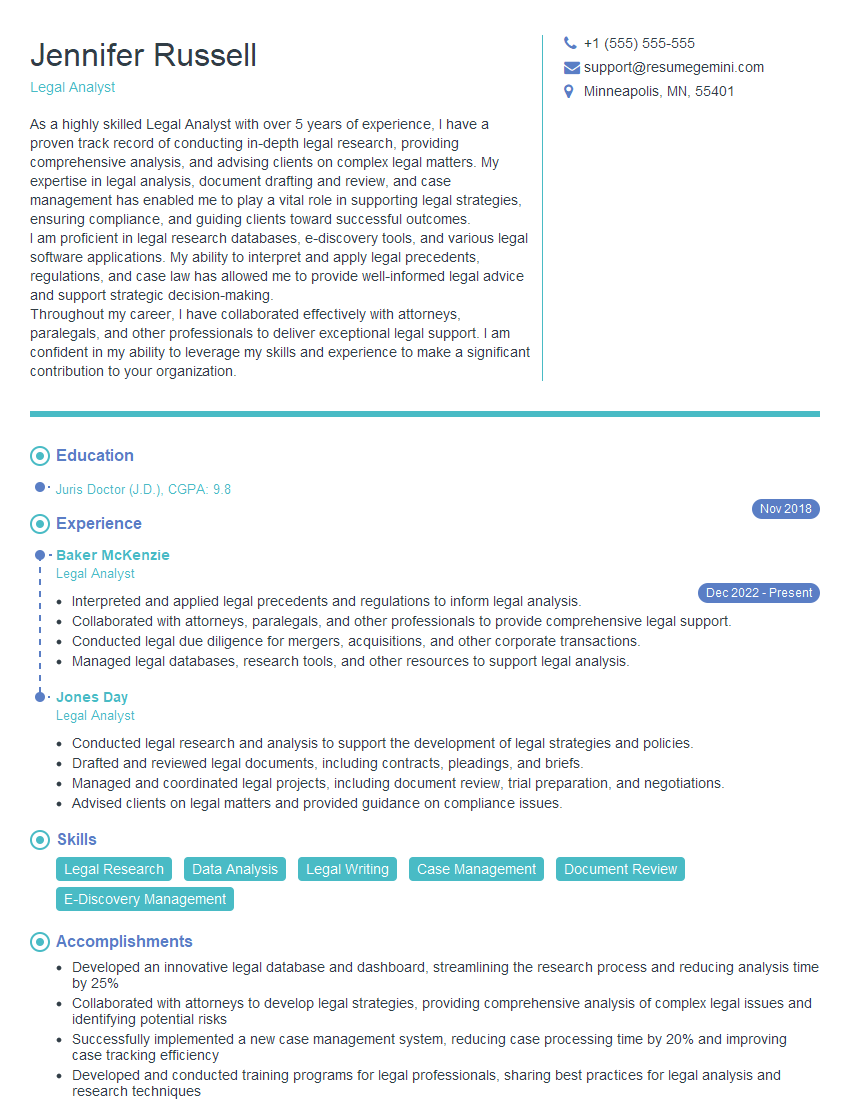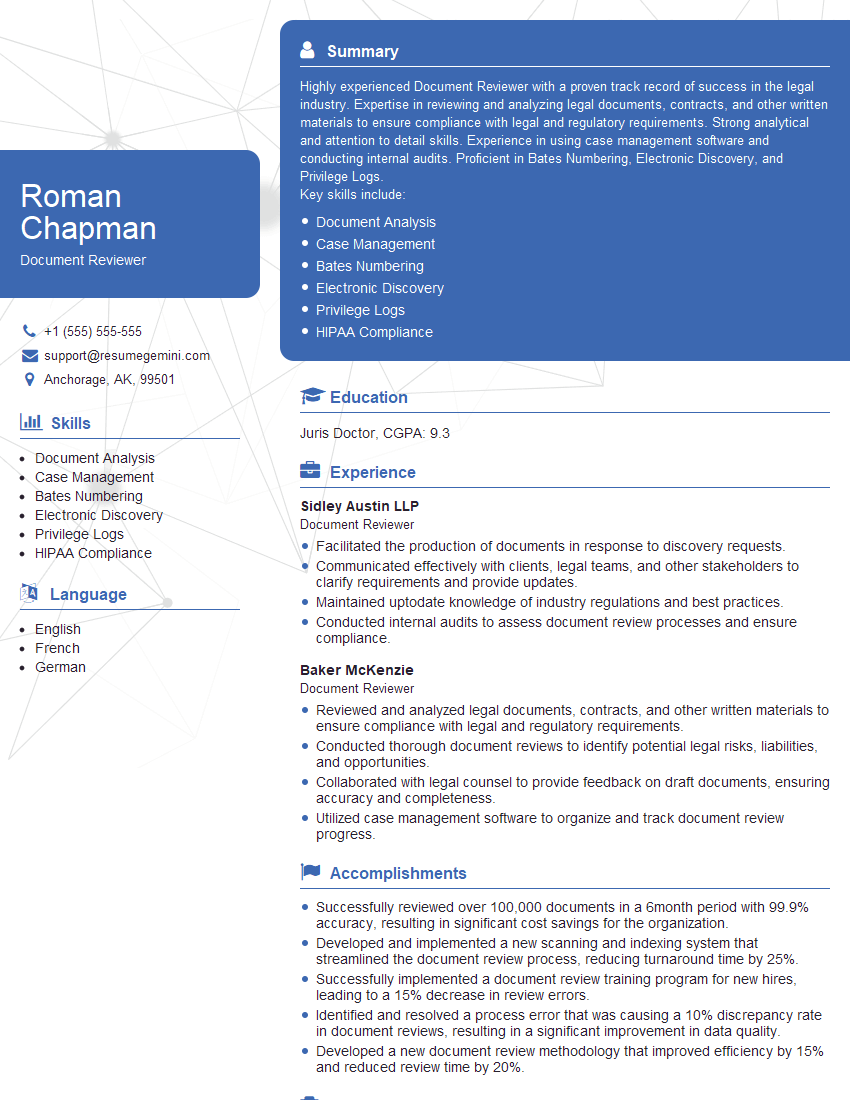Preparation is the key to success in any interview. In this post, we’ll explore crucial Analyzing and Interpreting Legal Documents interview questions and equip you with strategies to craft impactful answers. Whether you’re a beginner or a pro, these tips will elevate your preparation.
Questions Asked in Analyzing and Interpreting Legal Documents Interview
Q 1. Explain the process of identifying key clauses in a complex contract.
Identifying key clauses in a complex contract is like finding the main characters in a novel. You need to understand the overall narrative, and then focus on the parts that drive the plot. It starts with a thorough read-through to grasp the contract’s purpose and the relationship between the parties. Then, I systematically look for clauses dealing with:
- Definitions: Understanding the meaning of key terms is crucial. For example, a contract might define ‘Intellectual Property’ broadly or narrowly, drastically affecting the rights of each party.
- Payment terms: These specify how much money is owed, when it’s due, and the consequences of late payment. Think of this as the financial backbone of the agreement.
- Governing law and jurisdiction: This dictates where any disputes will be resolved and under which legal system. Choosing the wrong jurisdiction can have massive consequences.
- Liability and Indemnification: These sections allocate risk and define responsibility for damages or losses. Imagine it as assigning roles in case something goes wrong.
- Termination clauses: These outline under what conditions the contract can be ended and the procedures involved. This is like the ‘escape clause’ in the story.
- Confidentiality provisions: These protect sensitive information exchanged between parties. Think of them as the ‘secrets’ of the contract.
I use a combination of keyword searches (e.g., ‘payment,’ ‘termination,’ ‘liability’) and careful reading of each section, noting any clauses that deviate significantly from standard contract language. This systematic approach helps ensure that no crucial aspects are overlooked.
Q 2. How do you approach analyzing a legal document for potential risks and liabilities?
Analyzing a legal document for risks and liabilities involves a similar approach to risk assessment in other fields: identification, analysis, and mitigation. First, I identify potential areas of risk by focusing on clauses concerning liabilities, indemnities, warranties, and guarantees. I then analyze the scope and extent of these potential risks – how likely are they to occur, and what would the consequences be if they did?
For instance, a poorly drafted indemnity clause could leave one party exposed to significant financial losses. A vague warranty could lead to disputes over whether it’s been breached. I carefully examine the language of these clauses, looking for ambiguities, exceptions, and limitations. Finally, I assess the mitigation options. Can these risks be reduced or transferred through negotiation, insurance, or other means?
Consider a real estate contract: a poorly worded ‘as-is’ clause could expose the buyer to significant liability for unknown defects. My analysis would highlight this risk, exploring the specific wording of the clause, its potential impact, and whether the client could negotiate for additional protections like inspections or warranties.
Q 3. Describe your experience with legal research using online databases (e.g., LexisNexis, Westlaw).
I have extensive experience using online legal research databases such as LexisNexis and Westlaw. My proficiency encompasses using their advanced search functionalities to locate relevant case law, statutes, regulations, and secondary sources. I’m comfortable utilizing Boolean operators (AND, OR, NOT) and other search techniques to refine my searches and ensure efficient retrieval of relevant information.
For example, I recently used Westlaw to research the legal precedent surrounding a specific type of contract dispute in a particular jurisdiction. The advanced search functionality allowed me to quickly filter results based on jurisdiction, date, and keywords related to the case facts. This allowed me to efficiently identify and analyze key case law relevant to my client’s situation. I regularly utilize the citator functions to trace the history and subsequent treatment of cases, ensuring I have a complete and up-to-date understanding of the law. I’m also familiar with utilizing these platforms to locate relevant secondary sources such as legal articles and treatises to support my analysis and enhance my understanding of complex legal issues.
Q 4. How do you ensure accuracy and completeness in your analysis of legal documents?
Accuracy and completeness are paramount in legal analysis. My approach involves a multi-layered quality control process. First, I meticulously review each document multiple times, employing different strategies to catch inconsistencies. Then, I compare the information gleaned from the documents with other sources of information, such as publicly available records or information provided by the client. This cross-referencing helps to verify facts and identify discrepancies.
I also maintain detailed notes and maintain a systematic record of my research and analysis, which helps in identifying any errors or gaps in my understanding. Finally, I always seek a second opinion before finalizing my analysis; this review process is often done by a more senior legal professional, providing an extra layer of quality assurance.
Think of it like building a house: multiple inspections are needed at different stages to ensure the foundation is sound, the walls are straight, and the roof doesn’t leak. Similarly, multiple checks ensure the legal analysis is accurate and comprehensive.
Q 5. What strategies do you use to summarize complex legal information concisely?
Summarizing complex legal information concisely requires a structured approach. I begin by identifying the core issues and the key findings of my analysis. Then, I use a clear and simple writing style, avoiding legal jargon whenever possible. I prioritize using bullet points, tables, and other visual aids to present information in a digestible format. This helps the reader quickly grasp the essential information without getting bogged down in excessive detail.
For example, instead of writing a lengthy paragraph explaining the different types of damages available in a breach of contract claim, I might use a table outlining each type of damage, its definition, and an example. This approach improves readability and increases the likelihood of the reader understanding and retaining the key information.
Q 6. How would you handle conflicting information within a set of legal documents?
Handling conflicting information requires careful investigation and a methodical approach. I start by identifying the specific points of conflict and determining the sources of the conflicting information. I then evaluate the reliability and credibility of each source. Factors considered include the source’s expertise, potential biases, and the supporting evidence presented. The analysis needs to be objective; the goal is not to resolve the conflict simply in favor of one side, but to arrive at an understanding of the conflict’s nature and implications.
For instance, if a contract and a witness’s statement contradict each other regarding a specific event, I would examine the contract’s wording closely for ambiguities, review the witness’s credibility, and see if there’s corroborating evidence to support either claim. I may even need to consult additional sources of information to resolve the conflict. The aim is not to necessarily determine which is ‘right’ but to understand the nature of the conflict and its potential consequences.
Q 7. Describe your experience with different types of legal documents (e.g., contracts, wills, patents).
My experience encompasses a wide range of legal documents. I’ve worked extensively with contracts of all types, from simple sales agreements to complex commercial contracts and international agreements. This involves analyzing clauses concerning confidentiality, payment terms, liability limitations, intellectual property rights, dispute resolution mechanisms, and termination provisions.
I’ve also analyzed wills, focusing on testamentary capacity, the distribution of assets, and the validity of the will’s clauses. In patent analysis, I’ve reviewed claims, specifications, and prior art to assess the novelty and non-obviousness of an invention. My experience extends to reviewing corporate documents, such as articles of incorporation, bylaws, and shareholder agreements, and real estate documents such as deeds, leases, and mortgages. Each document type requires specific knowledge and a tailored analytical approach. Understanding the legal framework applicable to each document and its practical implications is crucial for effective analysis.
Q 8. Explain your approach to identifying ambiguities or inconsistencies in legal language.
Identifying ambiguities and inconsistencies in legal language requires a systematic approach. I begin by carefully reading the document, paying close attention to the phrasing of each clause and section. I look for instances where terms are defined differently in various parts of the document, or where clauses seem to contradict each other. For example, a contract might state a deadline in one section but a different, conflicting deadline in another.
My approach also involves considering the context. The intended meaning of a phrase can be significantly affected by its surrounding text. I look for vague or overly broad terms, such as ‘reasonable’ or ‘substantial,’ and consider how these might be interpreted differently by various parties.
- Cross-referencing: I compare clauses and sections to check for consistency.
- Definition analysis: I meticulously examine definitions of key terms to ensure clarity and avoid conflicts.
- Logical analysis: I trace the logical flow of arguments and identify any internal contradictions.
Think of it like solving a complex puzzle; each piece of text must fit perfectly with the others. If there’s a mismatch, it’s a flag for potential ambiguity or inconsistency that requires further investigation and potentially clarification from the relevant parties.
Q 9. How do you manage your time effectively when analyzing large volumes of legal documents?
Managing time effectively when analyzing large volumes of legal documents hinges on strategic planning and prioritization. I typically begin by gaining a high-level understanding of the entire document set, perhaps by reading executive summaries or reviewing indexing information if available. This gives me a ‘bird’s-eye view’ of the overall scope.
Then, I break down the task into smaller, manageable units. This could involve allocating specific time blocks to review individual documents or sections based on their perceived importance and complexity. For instance, I might dedicate more time to reviewing contracts than less crucial supporting documentation.
Using technology is essential. I utilize document review software with features like keyword searching, highlighting, and annotation to increase efficiency. Time-tracking tools also help me monitor progress and identify areas where I may need to adjust my approach.
Finally, consistent breaks are crucial to avoid burnout and maintain focus. Regularly stepping away from the task allows for a fresh perspective and helps in preventing errors.
Q 10. How do you prioritize tasks when working with multiple legal documents simultaneously?
Prioritizing tasks when working with multiple legal documents simultaneously necessitates a clear understanding of the overall objectives and deadlines. My approach involves a combination of factors to rank tasks:
- Urgency: Documents with immediate deadlines or those crucial for imminent decisions are prioritized.
- Importance: The potential impact of the document’s content on the case or client is considered. A critical contract will take precedence over a less consequential letter.
- Interdependency: I might need to analyze certain documents before others to properly understand the context. This requires a careful assessment of logical dependencies.
I often use project management tools or simple to-do lists to visualize my workload and track progress. This helps me stay organized and ensure that the most critical tasks receive timely attention. Think of it as a conductor leading an orchestra; each instrument (document) must play its part in the right order for the overall piece (legal matter) to be successful.
Q 11. How do you determine the relevance of information within a legal document?
Determining relevance within a legal document requires a deep understanding of the legal issue at hand and the context of the document. I start by clearly defining the scope of the analysis, identifying the key legal questions that need to be answered.
Next, I employ several strategies:
- Keyword searching: I use relevant keywords to quickly locate sections addressing specific issues.
- Contextual analysis: I carefully examine the surrounding text to understand the meaning and significance of specific phrases or statements.
- Legal framework: I refer to relevant statutes, regulations, and case law to evaluate the importance of the information within the document in relation to the legal framework.
For example, if analyzing a contract for potential breach of contract, I’d focus on clauses related to obligations, performance, and remedies. Information about company history or unrelated projects would be deemed less relevant. It’s like searching for a needle in a haystack; I must focus on identifying those pieces of information directly related to the legal question at hand.
Q 12. Describe your experience working with legal terminology and jargon.
I possess extensive experience navigating the complexities of legal terminology and jargon. My background in [mention relevant field, e.g., law, paralegal studies] has provided me with a solid foundation in understanding legal concepts and their associated language.
I actively maintain my knowledge by regularly consulting legal dictionaries, encyclopedias, and staying updated on legal developments. When I encounter unfamiliar terms, I meticulously research their meaning and context within the specific document. I also actively seek clarification from legal professionals if needed.
I am proficient in identifying and interpreting legal Latin terms, abbreviations, and technical vocabulary commonly used in various legal contexts. My ability to translate complex jargon into plain language is crucial for ensuring that non-legal professionals can understand the findings of my analysis.
Q 13. Explain your process for verifying the authenticity of legal documents.
Verifying the authenticity of legal documents is a critical aspect of my work. My process involves a multi-faceted approach:
- Source verification: I carefully examine the source of the document, checking for provenance and verifying the legitimacy of the issuing authority.
- Formal elements: I examine the document for proper formatting, signatures, seals, and other official markings as appropriate for the document type.
- Content verification: I analyze the internal consistency of the document’s content. Discrepancies or inconsistencies can indicate potential forgery.
- Digital signatures/timestamps: Where applicable, I verify the validity of digital signatures and timestamps using appropriate authentication methods.
- Third-party authentication: When necessary, I might seek verification from independent experts or official sources to confirm authenticity.
Authenticating legal documents demands meticulous attention to detail, as a single anomaly can signal a problem. My experience allows me to identify potential red flags and use appropriate verification techniques to ensure that only legitimate documents are considered in my analysis.
Q 14. How do you maintain confidentiality when handling sensitive legal information?
Maintaining confidentiality when handling sensitive legal information is paramount. My approach adheres to strict ethical guidelines and legal requirements.
First, I only access information on a need-to-know basis. Second, I use secure systems and storage solutions to protect data from unauthorized access. Third, I use strong passwords and follow all security protocols. Fourth, I never discuss sensitive information outside of the designated channels.
In addition, I am fully aware of the legal ramifications of breaching confidentiality and always prioritize data security. If the nature of the project requires it, I utilize confidentiality agreements and work within secure environments provided by my employer. I am committed to upholding the highest standards of professional ethics and data protection.
Q 15. How do you stay updated on changes in relevant laws and regulations?
Staying current in the ever-evolving legal landscape is paramount. I utilize a multi-pronged approach. First, I subscribe to reputable legal news sources and journals, such as LexisNexis and Westlaw, which provide daily updates and analysis on new legislation, case law, and regulatory changes. Second, I actively participate in professional development opportunities, including webinars, conferences, and continuing legal education courses, to deepen my knowledge and network with other legal professionals. Third, I leverage professional associations, such as the American Bar Association, to access their resources, publications, and expert insights. Finally, I maintain a robust network of contacts within the legal field to stay abreast of emerging trends and important developments through informal discussions and knowledge sharing.
Career Expert Tips:
- Ace those interviews! Prepare effectively by reviewing the Top 50 Most Common Interview Questions on ResumeGemini.
- Navigate your job search with confidence! Explore a wide range of Career Tips on ResumeGemini. Learn about common challenges and recommendations to overcome them.
- Craft the perfect resume! Master the Art of Resume Writing with ResumeGemini’s guide. Showcase your unique qualifications and achievements effectively.
- Don’t miss out on holiday savings! Build your dream resume with ResumeGemini’s ATS optimized templates.
Q 16. Describe your experience with using legal software or technology tools.
My experience with legal technology is extensive. I am proficient in using various legal research databases, including Westlaw and LexisNexis, to efficiently locate relevant case law, statutes, and regulations. I’m also skilled in using document review software, such as Relativity and Concordance, to analyze large volumes of documents quickly and accurately. Furthermore, I’m familiar with contract management systems that streamline the contract drafting, review, and approval processes. For instance, in a recent project involving a complex merger and acquisition, I leveraged Relativity to efficiently review thousands of documents, identifying key clauses and potential risks. This software significantly accelerated the due diligence process and improved the overall accuracy of our analysis.
Q 17. How would you explain a complex legal concept to someone without a legal background?
Explaining complex legal concepts to non-legal audiences requires clear communication and simplification. I avoid jargon and use analogies to illustrate the core concepts. For example, if explaining the concept of ‘burden of proof’ in a civil case, I might compare it to a seesaw: one side represents the plaintiff’s evidence, the other the defendant’s. The side with more weight – or more convincing evidence – wins. I also break down complex ideas into smaller, digestible parts, using simple language and real-world examples to make the information relatable and memorable. For example, explaining intellectual property rights, I might use the analogy of a creator owning their creation, like an artist owning their painting.
Q 18. How do you handle disagreements with colleagues regarding the interpretation of a legal document?
Disagreements are inevitable when interpreting legal documents. My approach is collaborative and solution-oriented. I begin by carefully reviewing the relevant sections of the document with my colleagues, clearly articulating my interpretation and the supporting legal basis. I actively listen to opposing viewpoints and respectfully explore different perspectives. We then engage in a constructive discussion, examining relevant case law, statutes, and legal precedents. If the disagreement persists, I suggest consulting additional resources or seeking a second opinion from a senior attorney or expert in the relevant area of law. The goal is always to reach a consensus based on sound legal reasoning and evidence.
Q 19. Describe a time you had to analyze a large and complex legal document under a tight deadline.
In a recent case, I was tasked with analyzing a 500-page commercial contract within a 24-hour timeframe. My strategy involved prioritizing key clauses, utilizing keyword searches and document review software to quickly identify critical terms and conditions. I created a detailed outline of the contract, focusing on crucial sections such as termination clauses, liability limitations, and payment schedules. By focusing on high-impact areas first, and employing efficient research and analysis techniques, I was able to deliver a comprehensive and accurate analysis within the tight deadline. This involved careful time management, prioritizing key sections, and leveraging technology to its fullest extent.
Q 20. How do you ensure the accuracy of your analysis when dealing with conflicting legal precedents?
Handling conflicting legal precedents requires a meticulous and systematic approach. I begin by identifying all relevant precedents, carefully analyzing their facts, reasoning, and holdings. I then evaluate the jurisdictions in which each case was decided, considering any relevant differences in state or federal laws. I assess the persuasiveness of each precedent, considering factors such as the age of the case, the court that decided it, and its subsequent citation history. By carefully weighing the strengths and weaknesses of each precedent and considering the specific facts of the case at hand, I arrive at a reasoned and well-supported conclusion, acknowledging the nuances and limitations of each precedent.
Q 21. What are the key differences between reviewing a contract for completeness versus for compliance?
Completeness and compliance reviews serve distinct purposes. A completeness review ensures all necessary clauses and terms are present in a contract. This focuses on the contract’s structure and whether it addresses all intended areas. A compliance review, however, examines whether the contract adheres to relevant laws, regulations, and internal policies. It ensures the contract’s legality and aligns with best practices. For example, a completeness review might check if a contract includes specific clauses relating to termination, payment, and dispute resolution, while a compliance review would verify whether the contract complies with consumer protection laws or data privacy regulations.
Q 22. Explain your understanding of the legal concept of ‘consideration’ in contract law.
Consideration, in contract law, is something of value exchanged by each party to a contract. It’s the ‘quid pro quo’ – the ‘something for something’ – that makes a contract legally binding. Without consideration, an agreement is generally unenforceable. It doesn’t have to be money; it can be a promise, an act, or a forbearance (giving up something you have the right to do).
- Promise: A promise to pay for goods or services is consideration. For example, promising to pay $100 for a painting is consideration.
- Act: Performing a service, like painting a house, in exchange for payment, is consideration. The act of painting is the consideration given by the painter.
- Forbearance: Agreeing not to do something you have the legal right to do, is consideration. For example, a creditor agreeing not to sue a debtor in exchange for partial payment is consideration.
It’s important to note that consideration must be sufficient, meaning it must have some value in the eyes of the law, but it doesn’t need to be adequate. This means the exchange doesn’t have to be perfectly balanced; one party might get a better deal than the other, but as long as there’s consideration from both sides, the contract is likely enforceable.
Example: Imagine I promise to give you my bicycle, but you don’t promise or do anything in return. This is likely not a legally binding contract because there’s no consideration from your side.
Q 23. How would you approach analyzing a contract for potential breach of contract?
Analyzing a contract for potential breach involves a systematic approach. First, I carefully review the contract to identify the parties’ obligations. This often involves creating a summary of key obligations for each side. Then, I compare those obligations to the alleged actions (or inactions) of the breaching party. I look for any material breach – that is, a breach that substantially impairs the value of the contract to the non-breaching party. A minor breach, that doesn’t significantly affect the contract’s purpose, might require a different approach (e.g. a request for performance).
Step-by-step approach:
- Identify the key contractual terms: Pinpoint specific promises and conditions outlined in the agreement.
- Establish the alleged breach: Clearly outline the actions or inactions claimed to constitute the breach.
- Determine materiality: Assess the impact of the breach on the non-breaching party. Does it significantly hinder the purpose of the agreement?
- Consider defenses: Evaluate any potential defenses the breaching party may raise (e.g., impossibility of performance, frustration of purpose, waiver).
- Analyze remedies: Determine the appropriate remedies for the non-breaching party, such as monetary damages, specific performance, or rescission.
Example: A construction contract specifies completion by a certain date. If the contractor fails to complete the project by that date without a valid excuse, this could be a material breach, entitling the client to damages.
Q 24. Describe your experience with due diligence reviews and identification of legal risks.
My experience in due diligence reviews involves a meticulous examination of legal documents to uncover potential risks. This often includes reviewing contracts, leases, permits, licenses, litigation history, and regulatory compliance records. The goal is to provide a comprehensive assessment of legal liabilities and potential issues that could affect a transaction or investment.
Identifying Legal Risks: I employ a risk-based approach, prioritizing areas with the highest potential for financial or reputational damage. For example, I’d focus on clauses relating to indemnities, limitations of liability, and potential environmental liabilities. I also look for potential conflicts of interest, non-compliance with relevant laws and regulations, and any pending or threatened litigation.
Example: In a recent due diligence review for a real estate acquisition, I discovered a pending environmental lawsuit related to contamination on the property. This discovery allowed the client to renegotiate the purchase price or walk away from the deal, avoiding a significant financial risk.
Q 25. How do you ensure that your analysis is free from bias and personal opinions?
Maintaining objectivity is paramount in legal analysis. I actively employ several strategies to mitigate bias:
- Conscious awareness: I acknowledge my own potential biases and actively work to set them aside. This includes being mindful of my personal values and beliefs and how they might influence my interpretation of legal documents.
- Structured approach: I use a standardized, systematic approach to analysis, applying consistent methodologies to all cases, reducing the impact of individual preferences.
- Fact-based analysis: I focus solely on the facts presented in the legal documents and relevant supporting evidence, avoiding assumptions or subjective interpretations.
- Seeking diverse perspectives: When appropriate, I discuss my analysis with colleagues, particularly those with differing backgrounds and experiences, to gain alternative viewpoints and identify potential blind spots.
- Regular self-reflection: I regularly review my work for any evidence of bias, seeking feedback and conducting self-assessments to identify areas for improvement.
Example: When reviewing a contract, I might consciously focus on the specific language used, rather than on my assumptions about the intentions of the parties involved. This helps avoid potential bias based on my perception of the parties.
Q 26. Explain your understanding of different types of legal clauses (e.g., indemnity, limitation of liability).
Legal clauses serve crucial functions in defining the rights and obligations of parties in a contract. Here are a few examples:
- Indemnity Clause: This clause shifts the responsibility for losses or damages from one party to another. For example, a contractor might indemnify the client against losses arising from the contractor’s negligence.
- Limitation of Liability Clause: This clause limits the amount of damages one party can recover from the other in case of breach of contract or other liability. It’s a way to cap potential financial exposure.
- Force Majeure Clause: This clause addresses events beyond the parties’ control (like natural disasters or wars) that may prevent performance of contractual obligations. It usually excuses performance in such events.
- Confidentiality Clause (Non-Disclosure Agreement): This clause protects confidential information shared between the parties during negotiations or the course of the contract.
- Termination Clause: This clause outlines the conditions under which either party can terminate the contract. It defines the consequences of termination.
Understanding these clauses and their implications is critical for assessing the risks and obligations associated with a contract. Different clauses will be more or less relevant depending on the specific nature of the contract and the parties’ objectives.
Q 27. How do you identify and address potential ethical dilemmas in your work?
Ethical dilemmas can arise in legal analysis. My approach centers on adherence to professional standards, maintaining client confidentiality, and acting with integrity. I prioritize objectivity and impartiality, and avoid conflicts of interest. When facing ethical challenges, I employ the following steps:
- Identify the ethical issue: Clearly define the nature of the conflict.
- Consult relevant codes of conduct: Review professional guidelines and regulations to understand the applicable standards.
- Seek advice: Discuss the dilemma with a trusted supervisor or mentor.
- Evaluate options: Consider various courses of action, carefully weighing their ethical implications.
- Document decisions: Maintain a record of the decision-making process to ensure accountability and transparency.
Example: If I discover that a client is involved in potentially fraudulent activity, I have an ethical obligation to report it, even if it compromises my professional relationship with that client. This requires careful consideration and potentially difficult conversations, but upholding the law and acting with integrity are paramount.
Q 28. Describe your experience with summarizing and presenting your findings to non-legal audiences.
Communicating complex legal findings to non-legal audiences requires clear, concise, and accessible language. I avoid legal jargon and technical terms whenever possible. I use visual aids like charts, graphs, and presentations to illustrate key points and make the information easily digestible. My approach involves simplifying complex issues into straightforward summaries that highlight the main findings and their practical implications.
Techniques used:
- Plain English summaries: I translate legal terminology into everyday language.
- Visual aids: I use charts and graphs to present data and findings in an easily understandable format.
- Analogies and metaphors: I use relatable examples to explain complex concepts.
- Interactive presentations: I engage the audience through questions and discussions to enhance understanding.
- Tailored communication: I adapt my communication style to the specific audience and their level of legal knowledge.
Example: In presenting findings to a board of directors, I’d focus on the key business risks and potential financial impacts, rather than delving into detailed legal arguments.
Key Topics to Learn for Analyzing and Interpreting Legal Documents Interview
- Legal Terminology and Definitions: Understanding key legal terms, concepts, and their nuances is fundamental. Practice identifying and defining terms within context.
- Document Structure and Format: Analyze various legal document types (contracts, statutes, briefs, etc.) to understand their structure and how information is presented. Practice identifying key clauses and sections.
- Legal Reasoning and Argumentation: Learn to identify the logical flow of arguments, supporting evidence, and conclusions within legal documents. This includes understanding deductive and inductive reasoning in a legal context.
- Fact Identification and Synthesis: Practice extracting relevant facts from complex legal documents and synthesizing them to understand the overall narrative and implications.
- Interpretation of Ambiguity and Contradictions: Develop skills in identifying and resolving ambiguities, inconsistencies, and contradictions within legal texts. Consider different interpretations and their potential consequences.
- Application of Legal Principles: Learn to apply relevant legal principles and precedents to interpret specific clauses and provisions in legal documents. Consider practical scenarios and case studies.
- Ethical Considerations: Understand the ethical responsibilities involved in analyzing and interpreting legal documents, including maintaining confidentiality and objectivity.
- Case Law Research and Application (if applicable): Depending on the role, understanding how to research and apply relevant case law to interpret legal documents may be crucial.
Next Steps
Mastering the art of analyzing and interpreting legal documents is crucial for career advancement in various legal and compliance-related fields. It opens doors to exciting opportunities and demonstrates a highly valued skillset. To maximize your job prospects, invest time in crafting a compelling and ATS-friendly resume that highlights your abilities. ResumeGemini can help you build a professional and effective resume tailored to showcase your expertise in this area. We provide examples of resumes tailored to Analyzing and Interpreting Legal Documents to guide you. Take the next step towards your dream career – create a powerful resume with ResumeGemini today!
Explore more articles
Users Rating of Our Blogs
Share Your Experience
We value your feedback! Please rate our content and share your thoughts (optional).
What Readers Say About Our Blog
Hi, I’m Jay, we have a few potential clients that are interested in your services, thought you might be a good fit. I’d love to talk about the details, when do you have time to talk?
Best,
Jay
Founder | CEO





